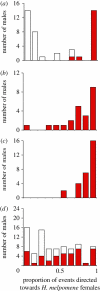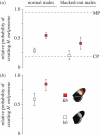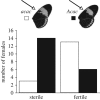Pervasive genetic associations between traits causing reproductive isolation in Heliconius butterflies
- PMID: 20810445
- PMCID: PMC3025683
- DOI: 10.1098/rspb.2010.1493
Pervasive genetic associations between traits causing reproductive isolation in Heliconius butterflies
Abstract
Ecological speciation proceeds through the accumulation of divergent traits that contribute to reproductive isolation, but in the face of gene flow traits that characterize incipient species may become disassociated through recombination. Heliconius butterflies are well known for bright mimetic warning patterns that are also used in mate recognition and cause both pre- and post-mating isolation between divergent taxa. Sympatric sister taxa representing the final stages of speciation, such as Heliconius cydno and Heliconius melpomene, also differ in ecology and hybrid fertility. We examine mate preference and sterility among offspring of crosses between these species and demonstrate the clustering of Mendelian colour pattern loci and behavioural loci that contribute to reproductive isolation. In particular, male preference for red patterns is associated with the locus responsible for the red forewing band. Two further colour pattern loci are associated, respectively, with female mating outcome and hybrid sterility. This genetic architecture in which 'speciation genes' are clustered in the genome can facilitate two controversial models of speciation, namely divergence in the face of gene flow and hybrid speciation.
Figures




References
-
- Coyne J. A., Orr H. A. 2004. Speciation. Sunderland, MA: Sinauer
-
- Mayr E. 1963. Animal species and evolution. Cambridge, MA: BelKnap
-
- Servedio M. R. 2009. The role of linkage disequilibrium in the evolution of premating isolation. Heredity 102, 51–5610.1038/hdy.2008.98 (doi:10.1038/hdy.2008.98) - DOI - DOI - PubMed
-
- Gavrilets S. 2004. Fitness landscapes and the origin of species. Princeton, NJ: Princeton University Press
-
- Noor M. A. F., Grams K. L., Bertucci L. A., Reiland J. 2001. Chromosome inversions and the reproductive isolation of species. Proc. Natl Acad. Sci. USA 98, 12 084–12 08810.1073/pnas.221274498 (doi:10.1073/pnas.221274498) - DOI - DOI - PMC - PubMed
Publication types
MeSH terms
Grants and funding
LinkOut - more resources
Full Text Sources
